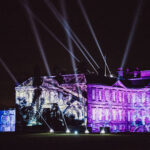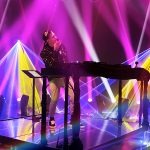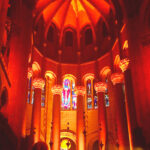There’s nothing that comes close to the Annual Walmart Shareholders Meeting as employees gather from around the world in Fayetteville, Arkansas to celebrate all things Walmart, the most profitable retailer in the world since 1988. Founder Sam Walton held the first shareholders meeting in 1970 when he presided over five others at a coffee shop table in Bentonville, the company’s headquarters. Each year the event grew, and since 1994, it has been held on the University of Arkansas campus in Bud Walton Arena, home to the Razorbacks basketball teams. This year, Walmart associates and shareholders filled the arena.
It’s part meeting, part concert, part awards show. Everything business-related is included—from electing new officers to reviewing earnings, highlighting associates who go above and beyond for customers. The rest of the time is an entertainment extravaganza for the associates and shareholders with A-list celebrities and entertainment.
Think Grammys meets General Sessions. Think superstars of pop and rock doing what they do best while top executives rock the audience with critical messages and yearly results. Think an international audience of nearly 15,000 representing 28 countries viewing the simultaneous webcast. Think big. Really big. Now you have an inkling of what this event is like.
The Production Team
The creative team at Walmart Event Solutions Group turns to a core of veteran professionals at Leo Events including David Kenyon, senior VP of production, who served as project manager. Leo Events, which has offices in Memphis, Chattanooga and Nashville, employs 50 fulltime within three focus areas: Meeting and Event Management; Creative, Content and Brand Development; and Production Services.
Says Kenyon, “The Walmart Group loves high-end technology, and every year seeks to outdo the previous year’s festivities. They are not afraid to throw challenges at us. We all gather in a large conference room and receive a verbal brief, which lasts about eight hours. It is a highly collaborative environment between the Leo team and the Walmart creative team.”
While many public companies have sedate meetings defined by their lack of production, Walmart pulls out all the stops: headliner entertainment, media heavy presentations, inspiring stories from the workforce and business-centric updates from the leadership team make for a busy morning for executives and a busy week for the production staff.
The challenges upfront are the extremely short timeline coupled with the difficulty of producing a show of this scope in an arena built for college basketball games. Kenyon points out that the combination of those two ingredients is a recipe for a potentially high stress environment.
“For a meeting of this scope, Bud Walton Arena is extraordinarily difficult to work in,” he says. “The basketball court allows for zero backstage area, and there is only one ramp for the 60 trucks it takes to move in this show. Everything is tight. But we thrive on all the challenges this event presents to us. Over the years, we have cherry-picked a talented team of vendors and contractors with the right personalities to join our Walmart team.”
During the week, two nights are reserved for concerts open to the public. This year they featured Rascal Flatts, Walk the Moon and Sheryl Crow. During the 2017 Shareholders Meeting itself, the A-List of acts included Gwen Stefani, Mary J. Blige, Ne-Yo and Rachel Platten, with Blake Shelton emceeing the event.
“Kenyon is really the key,” says technical director Steve Barrett. “He knows how to anticipate what they expect. This makes my job so much easier. You can have a conversation with him, and usually he is a few steps ahead of you, which is rare in the corporate world. Usually a person in Kenyon’s position is coming from a producer’s point of view, not a production point of view.”
As executive producer, Pete Cappa plays a dual role, that of working with the client and the rest of the Leo team. The event is a huge, high profile show that requires a massive set because it has to meet so many criteria of usage. “This is yet another reason for our selection of repeat vendors,” says Cappa. “When David communicates to them, they know what he wants them to bring to the table. Of course, it is our technical director, Steve Barrett, who really drives that process, while keeping me and the owners informed of the progress,” Cappa adds. “Matter of fact, the show is so complicated, it requires two TD’s, the other being Jim Dorroh.”
“I’m really more in a production management position,” Barrett explains. “The corporate world likes to call it TD. I take the concept, figure out how to get it in the room, make it work and handle all the on-property logistics; all the typical stuff you would as a production manager.”
Since the building doesn’t have a dock, Barrett offloads everything in the parking lot. “To get the show into the building we run a dozen forklifts up and down the ramp.”
A 90-foot decked tunnel ramp is built to the stage to handle all incoming band production trucks and the rapid set changes during the course of the event.
“The real saving grace is working with talented people who have done this before,” notes Barrett. “Leo is one of my absolute favorite groups to work with. The team they have in place is fantastic. Everybody knows their job really well, and they bring in a lot of young people who they spend an inordinate amount of time training. Everybody on Leo’s staff that I met is very smart, and they get it. The vendors are all at the top of their game, especially in the corporate world.”
Automation and Video
This year the combination of a giant curved LED screen by Creative Technologies and a sophisticated stage set created by CommuniLux, which came to be known as the “clamshell,” created a dynamic stage presence while facilitating several solutions for the show presentation.
“Typically we do a lot of automation with this show,” says Barrett. “This year involved a massive curved LED screen (165’ x 20’) which traveled at variable speeds to different trim heights throughout the event. An automated traveler curtain provided different aspect ratios by creating the illusion of only a center screen above the stage. The reveal of its entire length is definitely a wow moment.”
Side screens on left and right, each measuring 35’ 5” by 19’ 8”, flanked the main screen, creating video imagery from one end of the 175-foot stage to the other. Automated traveler curtains completed the look on these screens as well.
Set designer Star Kahn says of working with Chris Simmons, Leo’s creative director and production designer, “Chris brought the idea of a massive video screen to me. It’s nice to work with a creative director that brings you something that inspires you. The result of our collaboration was a very good designer process.”
Stephen Gray, COO of Creative Technologies (CT), has known and worked with David Kenyon for more than a decade. “This year’s meeting called for some very specific parameters to meet the needs of the producers,” says Gray. To meet those requirements CT provided the ROE CB-4, a proprietary product exclusively available in the U.S. through their company.
The ROE Carbon 4 is a 4.4mm pitch, lightweight LED screen perfect for when the application calls for very large scale displays without the weight of conventional high resolution products. The CB-4 weighs 50 percent less than a conventional 3.9mm display. Eliminating the dynamic shock load of moving the massive LED screen was essential to hanging the show in the Bud Walton Arena. Its actual weight was 8,000 pounds. A similar but heftier resolution product might top out around 18,000 pounds.
The CB-4 is backed by the Tessera software management system, which is a powerful and flexible control system well suited to large and complex displays.
The Clamshell
The other notable piece of automation, which came to be known as the “clamshell” was designed to solve a very simple problem; find a way to reveal, show, and hide the headline acts that played between presentations.
In the design process, it morphed into a multi-purpose scenic and lighting element as well. The structure was 16 feet tall at its highest point — large for a hard set piece. The inner and outer wall are separated by three feet of space for lighting fixture placement, as well as providing a stable width for the wheeled dolly travel track in the stage. Made of two separate half shell pieces, the “clamshell” could be closed in its downstage position, while the headliner set up or ended their set. In this position, the outer wall side has RP screen-like material, which was backlit from inside the wall. Gobos from Viper Performance front light provided patterned movement contrasting overlays.
“Unlike a televised awards show, there are no commercial breaks,” notes LD Greg Cohen, founding partner of Unlimited Visibility Lighting Design (UVLD). “During the entire four-hour event, we can never go to black for transitions.”
When open for reveals and performances, the onstage side comprised of Atomic panels are uplit and downlit by LED. Vertical LED tiles separated the panels adding another layer of video. “The Atomic panels take on light really well,” says Cohen, “giving us something interesting for the camera behind the headliners.”
“The genius of this clamshell was, I specifically did not want to see any rigging or cabling. All that had to be managed in a way that was hidden under the stage,” says Barrett. “CommuniLux came up with this crazy simple elegant system that allowed the thing to open and close freely with no visible motors or stagehands pulling wire.”
Lighting
UVLD’s Cohen has worked with Leo Events on Walmart’s annual shareholders meetings for the past few years. “We treat the event like a television show where the audience in the house really matters,” says Cohen. “That reflects everything we do. We light the show a little brighter and treat the audience a little more reverently. These folks, after all, are share and stake holders in Walmart.”
Cohen adds that, “from a design perspective, in terms of scenic, lighting, and video, we try to create a system the same way as lighting an award shows, which involves trying to have enough spectacles to reflect whatever the client wants to present, while at the same time creating visuals that are intimate enough to read well on camera.”
Upstaging provided the lighting for the event, along with Steve Wojda, who served as project manager, and crew members Josh Henderson and Brendan Langord. The rig included a variety of gear including Claypaky Mythos, Ayrton MagicBlade R’s, Robe Spiiders, Chauvet Strike 4’s, SGM Q7 LED strobes, Martin MAC Vipers and Quantum Wash LEDs and Vari-Lites, along with 136 ColorBlast 12 TRX, Lycian followspots and two grandMA2 consoles for control.
With one of those consoles available for backup, the entire show was controlled with one of the grandMA2 consoles. Matt Webb did programming and Mathew Piersy was the LD liaison for the headliner.
Over the stage, Cohen dedicated as many lighting fixtures as could possibly fit given the physical restraints. Much of the stage lighting system was hung on the 100-foot circle, which shared the shape of the curved LED screen. This played above the clamshell and was fully hidden, depending on trim position of the LED screen.
“With several A-list musical performances onstage, the event worked on a festival level at times,” Cohen says. “The rig needed to reflect that versatility, so became multi-purposed. We wanted a system that was visually rich that gave a strong back lite package so as the jib worked, the LED screen was complemented by the lighting system.”
A new feature at this year’s event was where the house band performed — on a totally separate stage, camera right. “This gave us clean and discrete camera shots without pulling focus from the stage,” says Cohen.
The audience package, which provided a general wash and air effects throughout the arena, also had 12 dedicated MAC Viper Profiles specifically for this purpose to hit areas the followspot couldn’t reach. “The Profiles also deliver enough light to give the camera some information about the audience behind the speaker, delivering a rich warm background of the audience surrounding the speaker so it did not look like they were in a black hole,” Cohen explains.
“It is so rewarding to do this show,” Cohen adds. “And though it is a challenging building, I actually like returning to it each year. The Walmart creative staff is not shy about throwing challenges at us regarding how they would like to shape each year’s event. Consequently, every show we have done has been a new experience each time.”
Upstaging’s Wojda notes that he and Leo Events’ Dave Kenyon have been friends for quite a few years. “I kept hitting him up about doing the event, and last year he gave us a shot,” Wojda says. “It went really well, and we were invited back this year.” Upstaging provided six trucks worth of lighting including their HUD truss.
In terms of the venue’s challenges, Wojda agrees wholeheartedly with everyone else’ assessment. “This is not a place a tour would stop,” he says, with a laugh. “Once you’re down that narrow tunnel and on the floor, there is no place for storage, no other corridors to push gear.” Consequently, the crew at the Upstaging shop loaded their trucks accordingly, with FOH gear at the rear and all upstage gear in the nose.
Onsite, Wojda became the de facto truck wrangler, overseeing the offloading and reloading of the 60 trucks for the show. His two Upstaging crew — Henderson and Langord — joined the three UVLD crew — Peter Campbell, Bill Moore and Gerry Walls, “which made a pretty rocking lighting team for a project so huge in scope.
“The fact is, this is such a well organized event, production wise, that the inherent roadblocks disappear with the team of people Leo Events gathers,” says Wojda. “Once the show is up and running and you are in the midst of the energy that huge crowd of Walmart shareholders put out, you just gotta stand back and say ‘Wow.’”
Rigging
As for rigging, this event is a 160-point show. A super grid supports 18 inverted CyberMotion Cyberhoists for the 167-foot curved LED screen. The show weighs just over 146,000 pounds. The beams are only accessible via lifts, so rigging takes place a week before actual load in.
Jason Adams lead rigger for Atlanta Rigging Systems (ARS), notes that ARS worked with CyberMotion US as a strategic partner for this event. The hoists pick up a custom rolled pipe built by CommuniLux, from which the screen hung. It’s staged at floor level several times throughout the show for business speakers and reveals. To achieve the radius called for on the circle truss design, ARS had to add spacers to the largest circle truss they could find. CommuniLux built a custom rolled pipe matching the curved screen to get the radius exactly matched to hang the curved screen. The Cyberhoists dropped chains down to a secondary truss, which the rolled truss pipe hung from to carry the LED screen.
“The major advantage that counters the building is we’re dealing with one of the biggest corporate clients in the world with a creative team that is very good, and they know exactly what they want,” says Barrett. “But that’s why we love this show. It is a challenge on many different levels.”
Walmart Annual Shareholders Meeting
CREW
LEO Events:
- Project Manager: David Kenyon
- Executive Producer: Pete Cappa
- Creative Director/Production Designer: Chris Simmons
- Technical Directors: Steve Barrett, Jim Dorroh
- Production Carpenter: Troy Morgan
Upstaging Crew:
- Project Manager: Steve Wojda
- Lighting Crew: Josh Henderson, Brendan Langord
Lighting & Set Design:
- Lighting Designer: Greg Cohen/UVLD
- UVLD Crew: Peter Campbell (ME), Bill Moore, Gerry Walls
- Set Designer: Star Kahn
- Scenic Builder: Alex Williams/CommuniLux
- Head Rigger: Jason Adams/Atlanta Rigging
CT and Video Crew:
- Project Manager: Matt Packer
- LED Techs: Luis Castillo, Jake Andrews, Daniel Whang
- Encore Op: Stephen Rousell
- Video EIC: Joe Levack
- Video Truck/Cameras: Nic Dugger/TNDV
- Watchout & Screen Media: Greg Page/PK Pictures
- Solotech: Dan Williams
- Sound Designer: John Williams
GEAR
Lighting (from Upstaging):
- 2 grandMA2 consoles (1 active, 1 for backup)
- 68 Claypaky Mythos 2 fixtures
- 64 Ayrton MagicBlade R fixtures
- 28 Robe Spiider LED wash fixtures
- 44 Martin MAC Viper Performances
- 26 Martin MAC Viper Profiles
- 24 Martin MAC Quantum Washes
- 18 Vari*Lite VL3500 Spots
- 30 Vari*Lite VL3515 Spots
- 41 Vari*Lite VL3500 Wash FX fixtures
- 24 SGM Q7 RGBW strobes
- 11 Chauvet Strike 4 LED blinders
- 4 Lycian M2 modular 2500 followspots
- 4 Lycian 1271/1272/M2 stands
- 136 ColorBlast 12 TRX LED fixtures
- 2 HES FQ-100 foggers
Video (from Creative Technologies):
- 480 ROE Creative Display CB4 LED panels
- 40 Martin Sceptron 1000mm battens
- 12 Martin Sceptron 320mm battens
- 3 Barco E2 systems
- 60 50-55” 4K LCD screens with signal distribution
Rigging (from Atlanta Rigging Systems/ARS):
- 160 Hoists (connected to building)
- 18 CyberHoists (inverted in truss)
- 2 ½-ton motors (for audio)
- 1,569’ Various truss
- 710’ Hud/GS Truss


